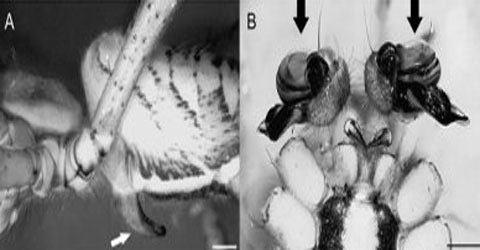The way to use 'precious' spider's escape is extremely toxic
Sex can be very dangerous, even brought to death if your partner intends to eat you.In some spiders, when males have sex for the first time and sometimes for the last time, they often apply defensive techniques: 'people who go, your quarter stays'.
>>>Spider-eating mates have a reason
Nephilengys malabarensis Spider is a predator when sex is present and males with external genitalia can be separated. This spider species has at most 2 mating opportunities: They have a pair of sperm transmission bodies, often called 'tentacles' but are actually similar to the penis. These tentacles will separate from the male spider body and continue to function satisfactorily on the spiders when they flee from the mating or because the spider threatens to 're-feed' them or because they want to 'slip' smoothly. Room for later lovemaking.
According to researcher Daiquin Li of the University of Singapore, in spiders, the separation of the sperm transfer organ from the male body is relatively common, but usually only the tip of these organs.
Speaking on LiveScience , Li added: 'However, some spiders apply the separation of the genitals' extremities (eunuch phenomenon), when the males completely remove the tentacles themselves while mating'.
The ultimate sacrifice

A: female spider, B: external genitalia consists of 1 pair
tentacles act as penis of male spiders.
Most researchers are still confused by the eunuch behavior of spiders. Experts don't really know why male spiders completely remove the penis, leaving them unable to mate. Some people initially suspected that this was a complete negligence at lovemaking.
Still, researcher Li believes that this behavior is definitely beneficial for male spiders, possibly storing and transmitting more sperm.
The researchers collected 50 immature spiders, including 25 females and 25 males that remained intact from Singapore and kept them in the laboratory until they reached the age of mating. They are mated in pairs by placing smaller males and female spider webs. The researchers recorded the time of mating delivery, the object of discontinuation of mating and the degree of separation of penis tentacles.
The result is that, after choosing to stop mating, the males leave the penis in their females during different time periods (up to 20 minutes). The team found that the male genitalia capable of breaking off sperm continued to pump sperm after the sex had ended.
'About 30% of sperm is transferred to the female before the male's penis is cut off. And about 70% of the sperm still in the tentacles are removed. In our experiments, pumping 85% of sperm took about 20 minutes, ' Li said.
The mating time is long

C: A part of the penis is separated from the male and stuck in the female,
D: close-up of penis tentacles with a claw of the male spider.
Research results show that, after females eat or threaten to remove the male, the male's penis remains in place and continues to transmit sperm long after the mating ends. In the lab, the females take about 7 hours to 'chase' the remaining penis. This prolonged sperm transfer does not occur if the male spider only breaks off the tip of the penis.
According to Mr. Li, the male part of the penis that has been cut off and left can act as a barrier to other males mating with females. Moreover, the eunuch males (if survived) will become more aggressive and watch their females to ensure that the remaining sperm in the severed penis can be transmitted to the offspring later, causing their father became more successful.
Spiders are not the only species that self-extinguished their penis. Mr. Li commented, prolonging sperm transmission activities may occur in other species possessing similar abilities as fire ants, earthen bees, scorpions and head-legged animals.
- Insects disguise as predators to escape
- Why do spiders spread silk?
- Share a fire escape when a director of a telecommunications company burns
- Spotted spiders transform into bird droppings
- Spiders re-solidify and birds
- Science has proven: Spider is a friend, not an enemy!
- Discovered an extremely rare giant 8-eye spider in Mexico
- Many new and rare spiders are found in Australia and India
- Science determines the time when spiders are most likely to occur in the home
- This is the color that people fear spiders should avoid wearing
- Spiders can also spread silk in the universe
- What if we swallow a spider?
 Why do potatoes have eyes?
Why do potatoes have eyes? 'Tragedy' the world's largest carnivorous life: Death becomes ... public toilet
'Tragedy' the world's largest carnivorous life: Death becomes ... public toilet Tomatoes were once considered 'poisonous' for 200 years
Tomatoes were once considered 'poisonous' for 200 years Detecting microscopic parasites on human face
Detecting microscopic parasites on human face